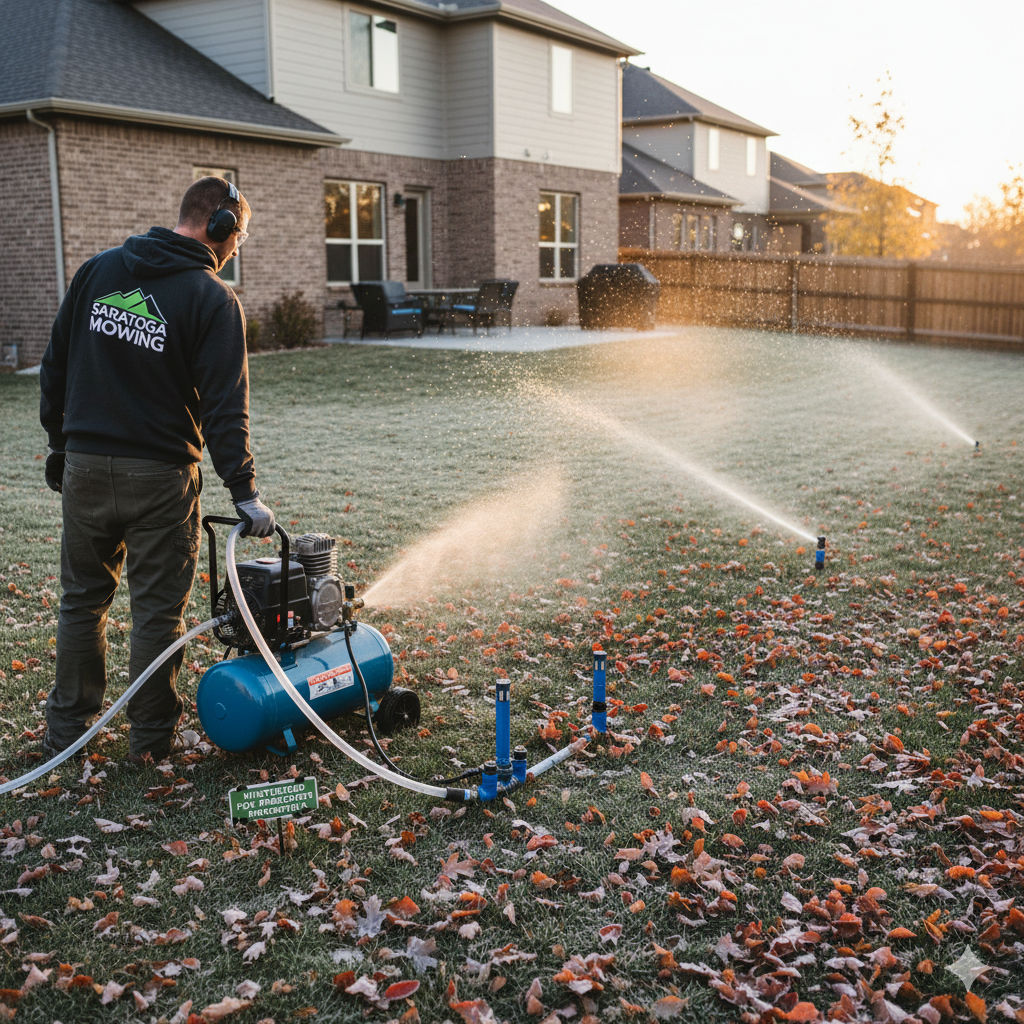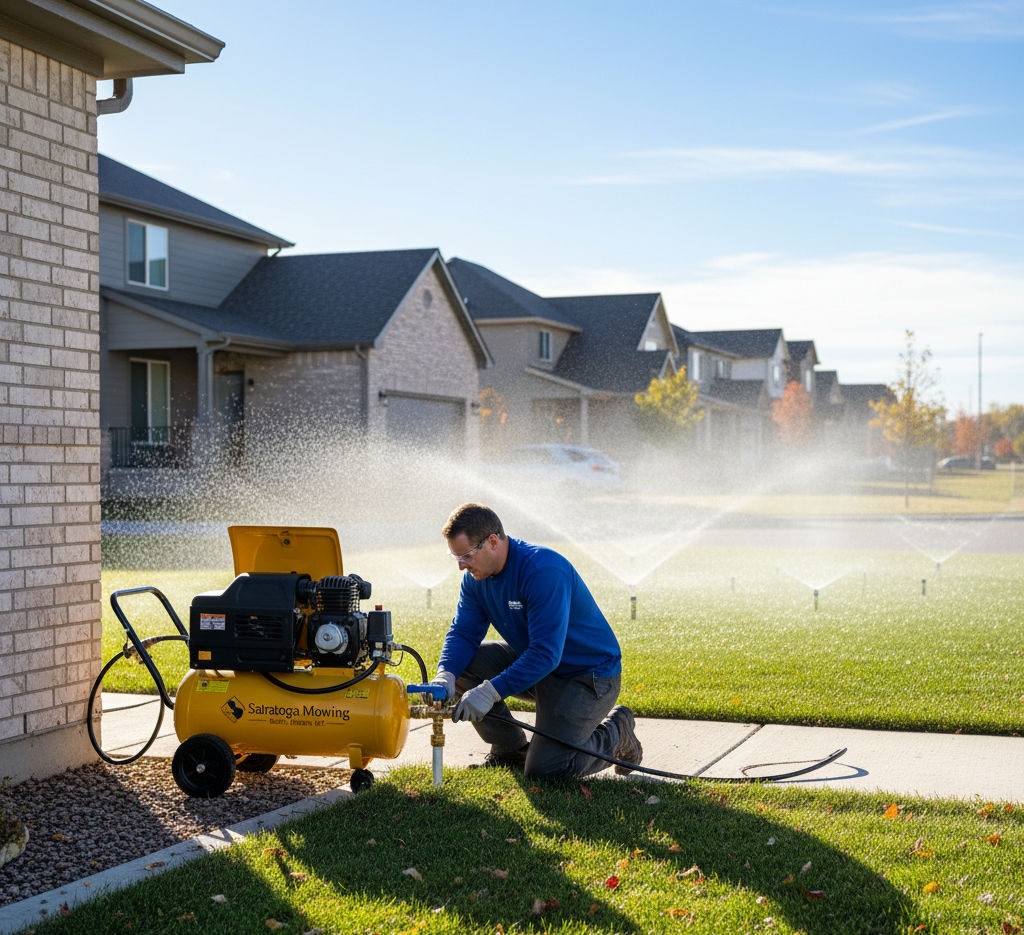The $3,000 Mistake Utah Homeowners Make Every Winter (And How a Simple Sprinkler Blowout Prevents It)
As the vibrant fall colors sweep across the Salt Lake Valley and the air in South Jordan gains its signature crispness, your mind might be on pumpkin patches and Halloween decorations. But there’s one critical, home-maintenance task that should be at the top of your list: your fall sprinkler blowout in Utah.
It might seem like a small, forgettable chore. However, procrastinating or skipping this service altogether is a gamble that could cost you thousands. Let’s break down the expensive physics of frozen water and how a simple, professional service protects your wallet.
The Silent Winter Threat Lurking Beneath Your Lawn
During a beautiful South Jordan autumn, it’s hard to imagine the deep freeze that January and February will bring. But the water left inside your underground irrigation lines doesn’t care about the season. It only follows one law of physics: water expands when it freezes.
This expansion is incredibly powerful. It can split metal engines and shatter stone. Your PVC or polyethylene sprinkler pipes and brass valves are no match for it. When the water in your system freezes, it expands with immense force, creating cracks in pipes, breaking sprinkler heads, and shifting valve housings.
The real disaster often strikes not during the deep freeze, but during the first spring thaw. That’s when you turn on your system, only to discover you’re not watering your lawn—you’re flooding it, from a network of leaks hidden beneath the surface.
Crunching the Numbers: The True Cost of a Skipped Blowout
So, what does this “$3,000 mistake” actually look like? It’s not a single repair; it’s a cascade of problems that adds up quickly.
A typical repair scenario for a burst underground pipe and damaged components often includes:
- Landscape Destruction: To access the broken pipe, landscapers or plumbers must trench through your lawn, often destroying sod, sprinkler lines, and landscaping.
- Repair Parts & Labor: This includes the cost of new PVC pipe, fittings, sprinkler heads, and valve repairs, plus the skilled labor to install them.
- Restoration: After the pipe is fixed, you’re left with a torn-up yard that needs new topsoil, grass seed, or sod to be restored.
When you add up the excavation, parts, labor, and lawn repair, a $2,500 – $4,000 bill is not uncommon. This makes investing in a professional sprinkler blowout service in Utah one of the smartest financial decisions you can make for your home each fall.
The Simple Solution: What is a Sprinkler Blowout and Why It’s a Job for Pros
A sprinkler blowout is the process of using a high-powered air compressor to force all standing water out of your irrigation system’s main lines, lateral pipes, valves, and sprinkler heads. The goal is to leave the system completely dry and safe from freezing.
Why is this a job for professionals? While it might seem straightforward, a proper Utah irrigation winterization requires specific knowledge and equipment.
- Correct PSI is Critical: Too little air pressure won’t clear the water effectively. Conversely, too much pressure can literally blow apart your pipes and valves from the inside, causing the very damage you’re trying to prevent. Professionals know the exact PSI for different types of systems.
- Specialized Equipment: The air compressors needed for an effective blowout are industrial-grade, not the small unit you might have in your garage.
- System Knowledge: A pro knows how to systematically open and close zones to ensure every last drop of water is evacuated, including from backflow preventers and drains.
Your Essential Fall Lawn Care Checklist for South Jordan
Scheduling your fall sprinkler blowout is the most critical step, but it’s part of a broader fall lawn care Utah strategy. Here’s a quick checklist to ensure your landscape is winter-ready:
- Schedule Your Blowout: The perfect time is after your last mowing of the season but before nighttime temperatures consistently drop below freezing. In South Jordan, this is typically from mid-October to mid-November.
- Drain and Disconnect Garden Hoses: This prevents faucets and exterior pipes from freezing.
- Fertilize Your Lawn: A fall fertilizer application provides nutrients for strong root growth over the winter, leading to a greener lawn in the spring.
- Aerate and Overseed: If you didn’t do this in early fall, it’s not too late! Aeration helps relieve soil compaction and allows water, air, and nutrients to reach the roots.
Don’t Gamble With a Costly Spring Surprise
Why risk a devastating repair bill and a torn-up yard for the sake of one quick and affordable service? A professional blowout is a minor investment with a massive return: peace of mind.

Ready to protect your South Jordan home from a $3,000 winter mistake?
[Schedule Your Affordable Sprinkler Blowout Service with Saratoga Mowing Today!]
Our local team is equipped with the right tools and expertise to winterize your system safely and efficiently, ensuring you have a healthy, leak-free start next spring.
Frequently Asked Questions (FAQ)
Q: When is the best time to get a sprinkler blowout in South Jordan?
A: We recommend scheduling your fall sprinkler blowout in Utah when nighttime temperatures consistently drop below freezing. In our area, aiming for late October through mid-November is a safe bet. Don’t wait for the first deep freeze!
Q: Can I winterize my own sprinkler system?
A: While it’s technically possible, we strongly advise against it. Using an incorrect PSI from a compressor that’s too small or too powerful is a leading cause of sprinkler pipe burst prevention failures. The cost of a professional service is far less than the cost of repairing a system damaged by a DIY attempt.
Q: How long does a sprinkler blowout service take?
A: For an average residential property in South Jordan, the entire process typically takes 30 to 60 minutes.
Q: What do I need to do to prepare for the service?
A: Simply ensure the technician has clear access to your backflow preventer and sprinkler manifold. It’s also helpful to mark any sprinkler heads that are hidden by leaf piles or overgrowth.


